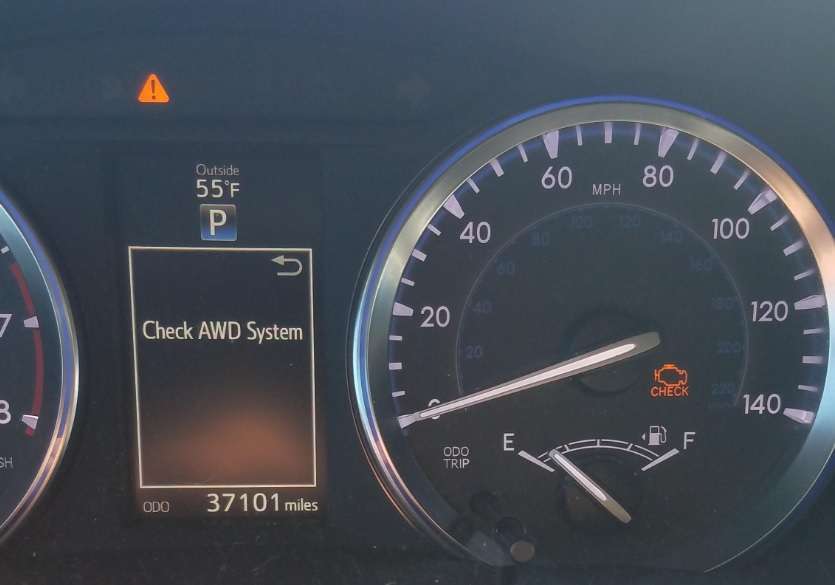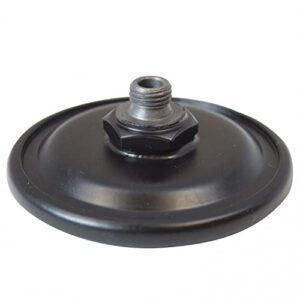The “check AWD system” message on a Toyota Highlander indicates a potential issue with the all-wheel drive system. It is important to diagnose and address the problem to ensure the proper functioning of the vehicle.
With its advanced technology, the Toyota Highlander offers an efficient and reliable all-wheel drive system.
Table of Contents
However, if you see the “check AWD system” message on the dashboard, it means there could be a problem with the system that needs attention.
The all-wheel drive system ensures optimal traction and stability, especially in adverse driving conditions.
Therefore, it is crucial to have the issue diagnosed and resolved by a qualified technician to maintain the vehicle’s performance and safety.
Neglecting the “check AWD system” warning could lead to potential drivability issues or even compromise the vehicle’s handling capabilities.
Understanding The Check Awd System Warning
The check AWD system warning is an important feature in the Toyota Highlander that alerts drivers to potential issues with the all-wheel drive (AWD) system.
This warning should not be taken lightly, as it can indicate problems that require immediate attention.

In this section, we will discuss the overview of the AWD system, the importance of the AWD system, and why the check AWD system warning appears.
Overview Of The AWD System
- The Toyota Highlander is equipped with an AWD system that distributes power to all four wheels, providing better traction and stability in various road conditions.
- The AWD system continuously monitors the vehicle’s speed, wheel slip, and other factors to determine when to engage or disengage the AWD functionality.
- It utilizes sensors and a sophisticated control module to automatically transfer power between the front and rear wheels, ensuring optimal performance in different driving situations.
Importance Of The Awd System
- The AWD system is crucial for maintaining control and stability, especially in adverse weather conditions like rain, snow, or ice.
- It improves traction when accelerating from a stop or when driving on slippery surfaces, reducing the likelihood of wheelspin and maintaining better control of the vehicle.
- The AWD system also enhances the vehicle’s handling and cornering capabilities, providing a safer and more comfortable driving experience.
Why Does The Check Awd System Warning Appear?
- The check AWD system warning appears when the vehicle’s AWD system detects a problem or malfunction.
- Possible reasons for this warning include a faulty sensor, electrical issue, malfunctioning control module, or mechanical problem within the AWD system.
- It is essential not to ignore this warning, as driving with a malfunctioning AWD system can lead to reduced traction and compromised safety.
- When the check AWD system warning appears, it is advisable to have the vehicle inspected and diagnosed by a qualified mechanic to identify and address the underlying issue.
Understanding the check AWD system warning is crucial for Toyota Highlander owners.
The AWD system plays a vital role in providing excellent traction, stability, and control. When this warning appears, it indicates a potential problem within the AWD system that requires immediate attention.
Ensuring the proper functioning of the AWD system contributes to a safer and more confident driving experience.
Common Causes For Check Awd System Warning
If you’re driving a Toyota Highlander and suddenly see the “check AWD system” warning light appear on your dashboard, it can be quite alarming.
This warning indicates that there is an issue with the all-wheel drive (AWD) system in your vehicle.
Understanding the common causes behind this warning can help you identify the problem and take appropriate action.
Here are some potential reasons why you might see the “check AWD system” warning:
Faulty Wheel Speed Sensors:
The wheel speed sensors play a crucial role in the AWD system. They monitor the speed of each wheel and send this information to the electronic control module (ECM).
If one or more of these sensors are faulty or malfunctioning, it can trigger the “check AWD system” warning.
Issues With The Electronic Control Module (Ecm):
The ECM is the brain of your vehicle’s AWD system. It receives data from various sensors and controls the operation of the system.
If there is a problem with the ECM, such as a software glitch or a hardware malfunction, it can cause the “check AWD system” warning to appear.
Problems With The Transfer Case:
The transfer case is responsible for distributing power between the front and rear wheels in the AWD system. If there is an issue with the transfer case, such as a worn-out component or a leak, it can trigger the warning light.
Malfunctioning Solenoids:
Solenoids are small electronic devices that control the flow of fluids in the AWD system. If one or more of these solenoids fail or get stuck, it can disrupt the proper functioning of the system and trigger the warning.
Damaged Wiring Or Connectors:
The AWD system relies on a complex network of wiring and connectors to transmit signals between various components.
If there is damage to the wiring or if the connectors are loose or corroded, it can result in a faulty connection and cause the “check AWD system” warning to appear.
Identifying the specific cause of the “check AWD system” warning requires proper diagnosis and troubleshooting by a qualified mechanic or technician.
It is advisable to avoid driving the vehicle extensively when this warning light is on to prevent further damage.
Taking your Toyota Highlander to a certified service center will ensure that the problem is accurately diagnosed and resolved, ensuring optimal performance of your AWD system.
Potential Consequences Of Ignoring The Check Awd System Warning
The check AWD system warning on your Toyota Highlander should never be taken lightly. Ignoring this warning can lead to a range of potential consequences that can significantly impact your driving experience and vehicle performance.
Below, we will explore some of the possible outcomes of disregarding the check AWD system warning.
Reduced Traction And Stability
- With the check AWD system warning present, your vehicle’s traction and stability are at risk of being compromised.
- The AWD system is designed to distribute power evenly to all four wheels, ensuring optimal grip on the road.
- Ignoring the warning may result in decreased traction, especially in slippery or challenging driving conditions such as rain or snow.
- Reduced stability can also occur, causing your vehicle to handle unpredictably and compromising your control behind the wheel.
Decreased Fuel Efficiency
- Ignoring the check AWD system warning can have an adverse effect on your Toyota Highlander’s fuel efficiency.
- Without the AWD system functioning properly, the vehicle may encounter additional resistance and drag.
- This increased resistance can lead to higher fuel consumption and decreased mileage per gallon.
- Over time, fuel costs can add up significantly, impacting your overall expenses.
Increased Risk Of Accidents
- Neglecting the warning can increase your risk of being involved in accidents.
- The AWD system plays a crucial role in providing stability, traction, and control.
- If the system malfunctions or is not functioning optimally, it can lead to unexpected vehicle behavior and difficulties in handling.
- This impaired control can result in an increased likelihood of accidents, especially during sudden maneuvers or emergencies.
Costly Repairs In The Future
- Ignoring the check AWD system warning can lead to more significant issues in the long run, potentially resulting in costly repairs.
- By addressing the warning promptly, you can prevent minor issues from developing into major problems.
- Continued operation without proper diagnosis and repair can place additional stress on other components of the AWD system.
- Ultimately, this may lead to extensive damage and the need for expensive repairs or part replacements.
It is essential to take the check AWD system warning seriously and address the underlying issues promptly.
By doing so, you can ensure the safety of yourself and your passengers, maintain optimal fuel efficiency, and prevent costly repairs in the future.
Don’t ignore the warning; instead, prioritize your Toyota Highlander’s performance and ensure a smooth and secure driving experience.
Steps To Take When The Check Awd System Warning Appears
Understanding The Different Warning Lights
- The check AWD system warning light is one of the many dashboard lights that you may encounter while driving your Toyota Highlander. It indicates that there is an issue with the all-wheel drive (AWD) system, which is responsible for distributing power to all four wheels of your vehicle.
- Another related warning light to be aware of is the AWD error light, which may also illuminate when there is a problem with the AWD system. While both lights indicate AWD system issues, it’s essential to understand the differences between them to assess the severity of the problem accurately.
- The check AWD system light usually indicates a less critical issue, such as a malfunctioning sensor or a temporary glitch in the system. It is typically safe to continue driving with this warning light illuminated, but it’s crucial to take the necessary precautions and inspect the vehicle to prevent potential damage.
Safely Pulling Over And Inspecting The Vehicle
- As soon as you notice the check AWD system warning light on your Toyota Highlander, it’s essential to pull over safely to prevent any further damage or potential accidents. Follow these steps to ensure your safety:
- Signal and gradually move your vehicle to the rightmost lane.
- Look for a safe and well-lit area, such as a parking lot or the side of the road, away from traffic.
- Engage your hazard lights to alert other drivers.
- Turn off the engine and engage the parking brake.
- Give the vehicle a few minutes to cool down before inspecting it.
- Once you have safely pulled over, inspect the vehicle for any visible signs of damage or issues. Pay attention to the following areas:
- Check for any leaks underneath the vehicle.
- Look for loose or disconnected wires near the AWD components.
- Inspect the tires for any signs of wear, punctures, or low pressure.
- Listen for any unusual noises coming from the AWD system or engine.
Checking And Resetting The Awd System
- After safely inspecting the vehicle, you can proceed with checking and potentially resetting the AWD system yourself. Keep in mind that these steps may vary depending on the specific Toyota Highlander model and year, so it’s always best to consult your owner’s manual for accurate instructions. Here’s a general guideline to follow:
- Start by turning off the engine and removing the key from the ignition.
- Wait for a few minutes before reconnecting the battery. This may reset the AWD system and clear any temporary issues.
- Reconnect the battery and ensure it is securely connected.
- Turn the ignition key to the “on” position without starting the engine. Observe the dashboard lights and check if the check AWD system warning light has disappeared.
- If the warning light persists, it’s advisable to schedule a visit to the dealership or reach out to a professional technician for further diagnostics and repairs.
Seeking Professional Assistance
- If the check awd system warning light persists even after inspecting and attempting to reset the awd system, it may indicate a more significant issue that requires professional assistance. Here are essential points to consider when seeking professional help:
- Contact your local Toyota dealership or a trusted automotive technician specializing in Toyota vehicles.
- Explain the issue and provide any relevant details about when and how the warning light appeared.
- Schedule an appointment for a thorough inspection and diagnostic test of the AWD system.
- Follow the technician’s recommendations for repairs or replacements, if necessary, to ensure your vehicle’s optimal performance and safety.
Remember, when it comes to AWD system warnings, it’s crucial to act promptly and take the necessary steps to address any underlying issues.
By understanding the warning lights, safely inspecting the vehicle, attempting a reset, and seeking professional assistance when needed, you can keep your Toyota Highlander’s AWD system in excellent working condition.
Seeking Professional Help For Awd System Issues
Toyota Highlander is a popular SUV known for its advanced features, including the check AWD system feature.
If you are a Highlander owner and have encountered the check awd system message on your dashboard, it is important to seek professional help to diagnose and fix any issues.
We will discuss the importance of consulting a certified Toyota technician, the diagnostic tools and procedures used by professionals, and common solutions for AWD system problems.
Importance Of Consulting A Certified Toyota Technician
- A certified Toyota technician has extensive knowledge and expertise in dealing with AWD system issues specific to the Toyota Highlander. They are trained to diagnose and fix problems accurately, ensuring the best possible solution for your vehicle.
- Toyota technicians have access to specialized resources, including diagnostic software and technical manuals, which enable them to identify the root cause of the AWD system problem efficiently.
- Consulting a certified technician ensures that any repairs or replacements are done using genuine Toyota parts, maintaining the performance and reliability of your Highlander.
- Professional help from a certified technician saves you time and money, as they can quickly pinpoint the problem and provide an effective solution, preventing further damage.
Diagnostic Tools And Procedures Used By Professionals
- Toyota technicians use advanced diagnostic tools, such as the tech stream diagnostic system, to communicate with the AWD system and retrieve error codes. This helps in identifying the specific component or system malfunction.
- The tech stream diagnostic system allows technicians to perform various tests, including reading live data and conducting system-specific tests, to accurately diagnose the problem.
- Visual inspection of the AWD system components, such as the transfer case, driveshaft, and differential, is conducted to identify any visible signs of damage or wear.
- Road tests may be performed to assess the vehicle’s handling and AWD system performance under real-world conditions, helping to further diagnose the issue.
Common Solutions For Awd System Problems
- Low or contaminated fluid levels in the AWD system can cause issues. A certified Toyota technician will check the fluid level and quality, and if necessary, perform a fluid flush or replace the fluid to ensure proper lubrication and functioning of the system.
- Faulty sensors, such as the wheel speed sensors or yaw rate sensors, can trigger the check awd system message. The technician will diagnose these sensors, replacing them if needed, to restore proper functionality.
- Wiring or electrical issues can also lead to AWD system problems. Professional technicians will inspect the wiring harnesses and connectors, repairing or replacing any damaged components.
- In some cases, the AWD system control module may need reprogramming or replacing to address the issue effectively. A certified technician will perform this task using specialized equipment to ensure proper calibration.
Remember, when it comes to AWD system problems in your Toyota Highlander, seeking professional help from a certified Toyota technician is crucial.
They have the expertise, diagnostic tools, and procedures to accurately diagnose and fix the issue.
Consulting a professional ensures that your vehicle’s AWD system operates optimally, providing you with a safe and enjoyable driving experience.
Preventive Measures To Avoid Awd System Issues
The AWD system in your Toyota Highlander is a valuable feature that enhances traction and stability, especially in challenging driving conditions.
While it is designed to provide a safer driving experience, it is important to take preventive measures to avoid AWD system issues.
By following these key steps, you can ensure the longevity and optimal performance of your AWD system.
Regular Maintenance And Inspections
Regular maintenance and inspections are essential to keep your AWD system in top shape. Here are some important points to consider:
- Scheduled maintenance: Adhere to your vehicle’s recommended maintenance schedule provided in the owner’s manual. This includes regular oil changes, filter replacements, and other routine maintenance tasks.
- Fluid levels: Check the fluid levels regularly, including the transfer case and differential fluids. Low fluid levels can lead to improper AWD system operation and potential damage.
- Visual inspections: Inspect the drivetrain components, including the driveshaft, CV joints, and boots, for any signs of damage or wear. Addressing issues promptly can prevent larger problems down the road.
Being Mindful Of Driving Habits
Your driving habits can have a significant impact on the health of your AWD system. Consider the following points:
- Avoid aggressive driving: Aggressive acceleration, braking, and cornering can put excessive stress on the AWD system components. Opt for smoother driving techniques to reduce strain.
- Avoid spinning wheels: When accelerating on slippery surfaces such as ice or mud, spinning wheels can strain the AWD system. Apply gentle and consistent pressure on the accelerator to maintain traction.
- Avoid overloading: Overloading your vehicle can put excessive strain on the AWD system. Be mindful of the weight capacity and distribute the load evenly to maintain proper balance.
Knowing The Limitations Of The Awd System
Understanding the limitations of your AWD system can help you make informed decisions when driving. Consider the following points:
- Not a substitute for safe driving: While the AWD system enhances traction, it is not a substitute for safe driving practices. Always maintain a safe distance, adhere to speed limits, and drive cautiously in hazardous conditions.
- Unequal tire wear: Uneven tire wear can lead to AWD system issues. Regularly inspect and rotate your tires to ensure even wear and optimal traction.
- Limited off-road capabilities: While the AWD system enhances off-road capabilities, it has limitations. Avoid extreme off-road conditions that could damage the AWD system components.
Staying Updated With Recalls And Service Bulletins
Staying informed about recalls and service bulletins is crucial for the health of your AWD system. Consider the following points:
- Manufacturer recalls: Regularly check for any manufacturer recalls specific to your Toyota Highlander’s AWD system. Contact your local Toyota dealership for any necessary repairs or updates.
- Service bulletins: Stay updated with service bulletins related to the AWD system. These bulletins often contain valuable information on potential issues or recommended maintenance procedures.
By following these preventive measures, you can ensure that your AWD system remains in good condition, providing you with a safer and more enjoyable driving experience.
Regular maintenance, mindful driving habits, understanding the system’s limitations, and staying informed about recalls and service bulletins will go a long way in avoiding AWD system issues.
Take care of your AWD system, and it will take care of you on the road.
Q&A
What Does “Check Awd System” Mean On Toyota Highlander?
The “check AWD system” warning message on the Toyota Highlander indicates a problem with the all-wheel drive (AWD) system. It is essential to have the system checked by a qualified technician to determine the specific issue and prevent further damage to the vehicle.
Ignoring the warning may lead to drivability issues and compromise safety on the road.
Conclusion
Understanding what the “check awd system” message means on your Toyota Highlander is crucial for maintaining the performance and safety of your vehicle.
This indicator is an alert that indicates a potential issue with the all-wheel drive system. Ignoring this warning could lead to further damage and hefty repair costs.
When you see this message, it is recommended to consult your vehicle’s manual to identify the issue and then take appropriate action, such as scheduling a service appointment with a certified Toyota technician.
Regular maintenance and timely repairs will ensure that your Toyota Highlander continues to operate at its best and provide a smooth and safe driving experience.
So, pay attention to the “check awd system” message and take the necessary steps to keep your Highlander running smoothly for years to come.



